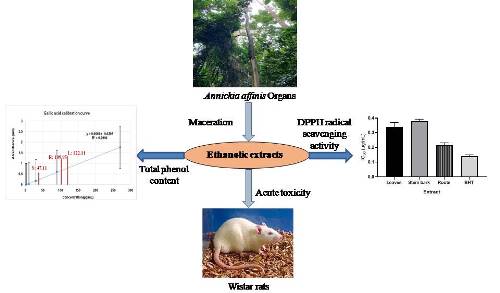
Phytochemical profile, antioxidant activity, and acute toxicity of methanolic extracts of Annickia affinis (Exell) Versteegh & Sosef leaves stem bark and roots
Abstract
Full Text:
PDFReferences
I.M. Siminialayi, E.O. Agbaje, Possible mechanisms for the anti-ulcer effects of the ethanolic extract of Enantia chlorantha in rats, West Afr. J. Pharmacol. Drug Res., 2005, 20, 39-43.
Y.P.A. Sambare, Collaboration entre médecine traditionnelle et médecine moderne au Burkina Faso: Entre discours et pratiques, Mémoire de Master, 2011.
World Health Organization, WHO traditional medicine strategy: 2014-2023. http://apps.who.int/iris/bitstream/handle/10665/92455/9789241506090_eng.pdf.
V.A. Kémeuzé, Millennium Ecologic Museum, Cameroon, 2022. https://uses.plantnet-project.org/fr/Annickia_affinis_(PROTA).
Z. Ali, J.B.F. Hzounda, C.C. Ngoule, J.C.N. Assob, F.M. Eya’ane, X.N. Siwe, J.M.M.E. Loe, J.E.T. Mbosso, Comparative Anti-plasmodial and Cytotoxic Effect of the Methanolic Extracts of Leaves, Stem Bark and Roots of Annickia affinis, Int. J. Biochem. Res. Rev., 2023, 32(1), 26-33.
N. Erhunse, S.E. Omoregie, D. Sahal, Antiplasmodial and antimalarial evaluation of a Nigerian hepta-herbal Agbo-iba decoction: Identification of magic bullets and possible facilitators of drug action, J. Ethnopharmacol., 2023, 301, 115807.
J.P. Mugiraneza, F. Nshimiyimana, E. Bajyana, Evaluation de l’efficacité de l’extrait éthanolique de Maytenus undata (Thumb.) Blakelock sur les germes responsables des diarrhées glairosanglantes, Life Sci. Nat. Sci., 2009, 17, 16 23.
F. Ronchetti, G. Russo, E. Bombardelli, A. Bonati, A new alkaloid from Rauwolfia vomitoria, Phytochemistry, 1971, 10, 1385-1388.
R. Hegnauer, Chemotaxonomie der pflanzen, band 6, Birkhäuser verlag, Basel und stuttgart, 1973.
G.J. Wagner, Isolation of membranes and organelles from plants cells, Academics Press, London, 1983.
Y.A. Békro, M.J.A. Békro, B.B, Boua, B.F.H. Tra, E.E. Ehilé, Étude ethnobotanique et screening phytochimique de Caesalpinia benthamiana, Sci. Nature, 2007, 4, 217-225.
OCDE guidelines for the testing of chemical/section 4: Health effects test No 423: Acute oral toxicity -Fixed dose procedure, 2002.
Y.C.F. Ladoh, S.D. Dibong, M.A. Nyegue, T.R.P. Djembissi, N.B. Lenta, M.E. Mpondo, J. Yinyang, J.D. Wansi, Activité antioxydante des extraits méthanoliques de Phragmanthera capitata (Loranthaceae) récolté sur citrus sinensis, J. Appl. Biosci., 2014, 84, 7636-7643.
W. Brand-Williams, M.E. Cuvelier, C. Berset, Use of a free radical method to evaluate antioxidant activity, LWT - Food Sci. Technol., 1995, 28, 25-30.
P. Gracia-Salas, A. Morales-Soto, A. Segura-Carretero, A. Fernandes-Guitierrez, Phénolic-compound-extraction systems for fruit and vegetable samples, Molecules, 2010, 15, 8813-8826.
T. Acamovic, J.D. Brooker, Biochemistry of secondary plant metabolites and their effects in animals, Proc. Nutri. Soc., 2005, 64, 403-412.
S. Goyal, C. Lambert, S. Cluzet, J.M. Mérillon, K.G. Ramawat, Secondary metabolites and plant defense, biological control, Netherlands: Springer, 2012.
B.F. Fekam, E. Madiesse, R. Tepongning, V. Ngouana, F.W. Mbacham, E. Tsamo, A.H.P. Zollo, J. Gut, J.P. Rosenthal. Antiplasmodial activity of extracts from seven medicinal plants used in malaria treatment in Cameroon, J. Ethnopharmacol., 2009, 123, 483-488.
E.A.M. Kemgne, W.F. Mbacham, F.F. Boyom, P.H.A. Zollo, E. Tsamo, PJ. Rosenthal, In vitro sensitivity of Plasmodium falciparum field isolates to extracts from Cameroonian Annonaceae plants, Parasitol. Res., 2012, 110(1), 109-117.
A.A. Adesokan, M.A. Akanji, M.T. Yakubu, Antibacterial potential potentials of aqueous extract of Enantia chlorantha stem bark, Afr.
J. Biotechnol., 2007, 6(22), 2502-2505.
A.A. Adesokan, M.A. Akanji, Antimalarial bioactivity of Enantia chlorantha stem bark, Pharmacol, 2010, 4(1), 441–447.
E.O. Agbaje, A.O. Onabanjo, The effects of extracts of Enantia chlorantha in malaria, Ann. Trop. Med. Parasitol., 1991, 85, 585–590.
J.O. Olanlokun, S.F. Akomolafe, Antioxidant potentials of various solvent extracts from stem bark of Enantia chlorantha, J. Biomed. Sci. Eng., 2013, 6, 877–884.
I.S. Gill, C. Akinwunmi, Nigerian folk medicine: Practices and beliefs of the Ondo people, J. Ethnopharmacol., 1986, 18(3), 259–266.
U.E. Odoh, I.V. Okwor, M. Ezejiofor, Phytochemical, trypanocidal and antimicrobial studies of Enantia chlorantha (Annonaceae) root, J. Pharm. Allied Sci., 2010, 7.
E.O. Agbaje, A.O. Onabanjo, Toxicological study of the extracts of antimalarial medicinal plant Enantia chlorantha, Cent. Afr. J. Med., 1994, 40(3), 71–73.
F.N. Njayou, P.F. Moundipa, A.N. Tchana, B.T. Ngadjui, F.M. Tchouanguep, Inhibition of microsomal lipid peroxidation and protein oxidation by extracts from plants used in Bamun folk medicine (Cameroon) against hepatitis, Afr. J. Tradi. Complement. Altern. Med., 2008, 5(3), 278–289.
J.O. Olanlokun, S.F. Akomolafe, Antioxidant potentials of various solvent extracts from stem bark of Enantia chlorantha, J. Biomed. Sci. Eng., 2013, 6, 877–884.
DOI: http://dx.doi.org/10.13171/mjc02303231693jean_emmanuel
Refbacks
- There are currently no refbacks.
Copyright (c) 2023 Mediterranean Journal of Chemistry
